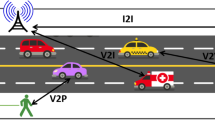Abstract
The Battery Management System of an Electric Vehicle is a system designed to ensure safe operation of the battery pack, and report its state to other systems. It is a distributed system, and the communication between its sub-modules is performed through wired buses. In this article, we study the opportunity to use a wireless technology named IEEE Std 802.15.4 Time Slotted Channel Hopping, a standardized protocol for low power and lossy networks. We first describe the real-world experiments we did to measure the link quality, at Medium Access Control layer, for wireless nodes placed inside an EV battery pack. Then, we propose two topology management and scheduling strategies using techniques named Linear Programming and Simple Descent, based on the results obtained in the experiments. Their goal is to achieve efficient data transfer while complying to the battery management constraints.























Similar content being viewed by others
References
IEEE Standard for Low-Rate Wireless Networks. (2016). IEEE Std 802.15.4-2015 (Revision of IEEE Std 802.15.4-2011) 1–709. https://doi.org/10.1109/IEEESTD.2016.7460875.
I3Mote for Industrial Internet of Things Reference Design. http://www.ti.com/lit/ug/tidud23a/tidud23a.pdf (2017). Texas Instruments.
Accettura, N., Palattella, M.R., Boggia, G., Grieco, L.A., & Dohler, M (2013). DeTAS: A decentralized traffic aware scheduling technique enabling IoT-compliant multi-hop low-power and lossy networks. In Second IEEE woWMom workshop on the internet of things: smart objects and services, iot-sos, Vol. 26.
Alexander, R., Brandt, A., Vasseur, J., Hui, J., Pister, K., Thubert, P., Levis, P., Struik, R., Kelsey, R., & Winter, T. (2012). RPL: IPv6 routing protocol for low-power and lossy networks. RFC 6550. https://doi.org/10.17487/RFC6550. https://rfc-editor.org/rfc/rfc6550.txt.
Alonso, D., Opalko, O., & Dostert, K. (2016). Parametrization of automotive lithium-ion batteries and its influence on the wireless in-battery channel. In Proceedings of the 2016 10th European conference on antennas and propagation (EuCAP) (pp. 1–5). https://doi.org/10.1109/EuCAP.2016.7481269.
Alonso, D., Opalko, O., Sigle, M., & Dostert, K. (2014). Towards a wireless battery management system: evaluation of antennas and radio channel measurements inside a battery emulator. In Proceedings of the 2014 IEEE 80th vehicular technology conference (VTC2014-Fall) (pp. 1–5). https://doi.org/10.1109/VTCFall.2014.6966212.
Bergveld, H.J., Kruijt, W.S., & Notten, P.H.L. (2002). Battery management systems, (pp. 9–30). Netherlands: Springer.
Bonfiglio, C., & Roessler, W. (2009). A cost optimized battery management system with active cell balancing for lithium ion battery stacks. In 2009 IEEE vehicle power and propulsion conference (pp. 304–309). https://doi.org/10.1109/VPPC.2009.5289837.
Chang, W.Y. (2013). The state of charge estimating methods for battery: a review ISRN Applied Mathematics 2013.
Chatzakis, J., Kalaitzakis, K., Voulgaris, N.C., & Manias, S.N. (2003). Designing a new generalized battery management system. IEEE Transactions on Industrial Electronics, 50(5), 990–999. https://doi.org/10.1109/TIE.2003.817706.
Du, P., & Roussos, G. (2012). Adaptive time slotted channel hopping for wireless sensor networks. In 2012 4Th computer science and electronic engineering conference (CEEC) (pp. 29–34). https://doi.org/10.1109/CEEC.2012.6375374.
Duquennoy, S., Al Nahas, B., Landsiedel, O., & Watteyne, T. (2015). Orchestra: robust mesh networks through autonomously scheduled TSCH. In Proceedings of the 13th ACM conference on embedded networked sensor systems (pp. 337–350). ACM.
Le Gall, G., Montavont, N., & Papadopoulos, G.Z. (2020). Enabling IEEE 802.15.4-2015 TSCH based wireless network for electric vehicle battery management. In 2020 IEEE symposium on computers and communications (ISCC) (pp. 1–6). https://doi.org/10.1109/ISCC50000.2020.9219551.
Lee, M., Lee, J., Lee, I., Lee, J., & Chon, A. (2013). Wireless battery management system. In Proceedings of the 2013 world electric vehicle symposium and exhibition (EVS27) (pp. 1–5). IEEE.
Martinez-Laserna, E., Sarasketa-Zabala, E., Villarreal Sarria, I., Stroe, D., Swierczynski, M., Warnecke, A., Timmermans, J., Goutam, S., Omar, N., & Rodriguez, P. (2018). Technical viability of battery second life: a study from the ageing perspective. IEEE Transactions on Industry Applications, 54(3), 2703–2713. https://doi.org/10.1109/TIA.2018.2801262.
Palattella, M.R., Accettura, N., Dohler, M., Grieco, L.A., & Boggia, G. (2012). Traffic aware scheduling algorithm for reliable low-power multi-hop IEEE 802.15. 4e Networks. In 2012 IEEE 23rd international symposium on proceedings of the personal indoor and mobile radio communications (PIMRC) (pp. 327–332). IEEE.
Pister, K., Phinney, T., Thubert, P., & Dwars, S. (2009). Industrial routing requirements in Low-Power and lossy networks. RFC 5673. https://doi.org/10.17487/RFC5673.
Piyare, R., Murphy, A.L., Kiraly, C., Tosato, P., & Brunelli, D. (2017). Ultra low power Wake-Up radios: a hardware and networking survey. IEEE Communications Surveys Tutorials, 19(4), 2117–2157. https://doi.org/10.1109/COMST.2017.2728092.
Sun, F., Hu, X., Zou, Y., & Li, S. (2011). Adaptive unscented kalman filtering for state of charge estimation of a Lithium-Ion battery for electric vehicles. Energy, 36(5), 3531–3540. https://doi.org/10.1016/j.energy.2011.03.059.
Tavakoli, R., Nabi, M., Basten, T., & Goossens, K. (2018). Topology management and TSCH scheduling for low-latency convergecast in in-vehicle WSNs. IEEE Transactions on Industrial Informatics 1–1. https://doi.org/10.1109/TII.2018.2853986.
Tuohy, S., Glavin, M., Hughes, C., Jones, E., Trivedi, M., & Kilmartin, L. (2015). Intra-vehicle networks: a review. IEEE Transactions on Intelligent Transportation Systems, 16(2), 534–545.
Wang, J., Cao, B., Chen, Q., & Wang, F. (2007). Combined state of charge estimator for electric vehicle battery pack. Control Engineering Practice, 15(12), 1569–1576. https://doi.org/10.1016/j.conengprac.2007.03.004.
Weicker, P. (2013). A systems approach to Lithium-Ion battery management artech house.
Zimmer, G. (2017). Wireless battery management systems highlight industry’s drive for higher reliability linear technology.
Acknowledgements
The authors would like to thank Pierre Couturier and Alexandre Meimouni from IMT Mines Alès, for their help and support in setting up the test described in Section 3.1.
Author information
Authors and Affiliations
Corresponding author
Ethics declarations
Conflict of Interests
The authors declare that they have no conflict of interest.
Additional information
Publisher’s Note
Springer Nature remains neutral with regard to jurisdictional claims in published maps and institutional affiliations.
Rights and permissions
About this article
Cite this article
Le Gall, G., Montavont, N. & Papadopoulos, G.Z. IoT Network Management within the Electric Vehicle Battery Management System. J Sign Process Syst 94, 27–44 (2022). https://doi.org/10.1007/s11265-021-01670-2
Received:
Revised:
Accepted:
Published:
Issue Date:
DOI: https://doi.org/10.1007/s11265-021-01670-2




